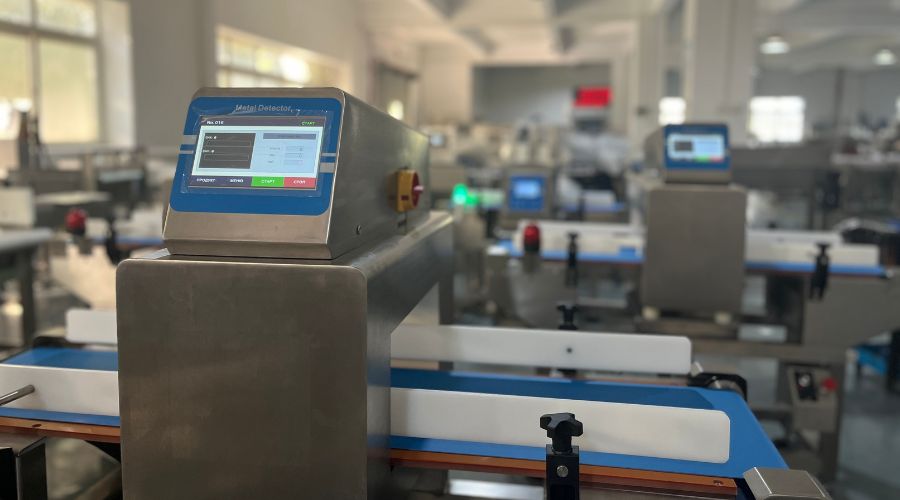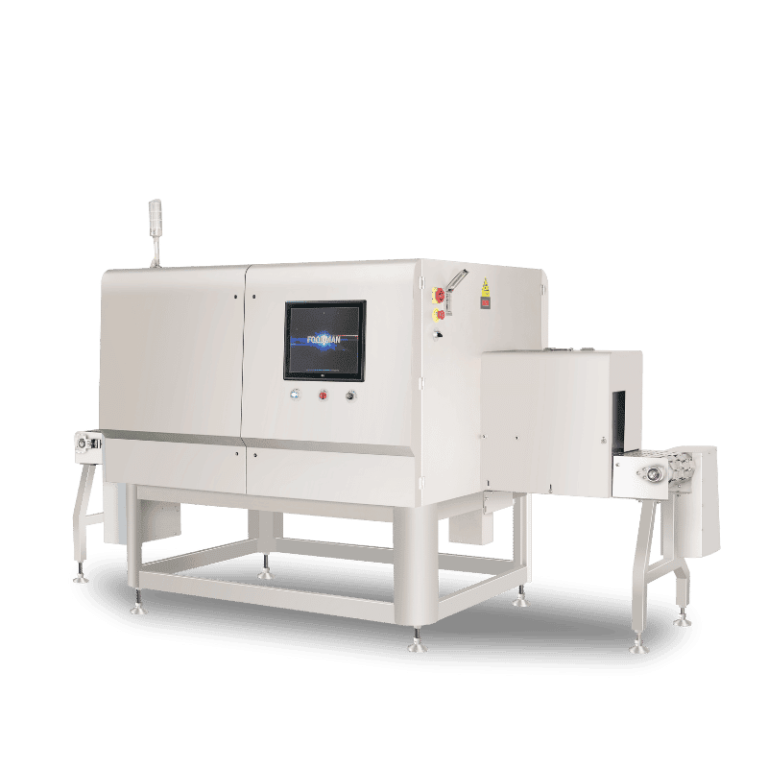Introduction
The Growing Importance of Consumer Trust and Regulatory Compliance in the Food Industry
In today’s global food industry, food safety is no longer just a regulatory requirement—it has become a cornerstone of consumer trust. With rising awareness among consumers and stricter regulations from agencies worldwide, food manufacturers must ensure that every product leaving the production line meets the highest safety standards. Failing to do so can lead to recalls, legal liabilities, and damage to brand reputation.

Highlight Rising Challenges: Contamination, Recalls, and Production Efficiency
Food production is a complex process, involving multiple stages where contamination can occur. Common challenges include foreign metal objects entering products through machinery, packaging, or handling errors. Even a tiny fragment can compromise food safety and result in costly recalls. At the same time, manufacturers face pressure to maintain production efficiency without slowing down the line, which creates a need for reliable, fast, and precise detection systems.
Introduce Metal Detectors as a Proactive Solution for Protecting Food Safety and Quality
This is where metal detectors in the food industry play a critical role. But how does a metal detector work in practice, and what exactly can it detect? Modern food metal detectors are designed to identify various types of metals, including ferrous, non-ferrous, and stainless steel, in packaged or bulk food products. Understanding how the metal detector works helps manufacturers implement them effectively.
Food industry metal detectors and metal detectors for food production lines are integrated directly into the manufacturing process, providing continuous, real-time monitoring. They ensure that contaminated products are identified and removed before reaching consumers. If you’ve ever wondered how do metal detectors work in food industry or what do metal detectors detect, the answer lies in their sophisticated electromagnetic sensing technology. Simply put, how a metal detector works involves generating a magnetic field and detecting disturbances caused by metal fragments, allowing manufacturers to maintain both food safety and quality control efficiently.
By leveraging metal detectors in food industry, companies can proactively prevent contamination, safeguard their brand reputation, and comply with increasingly stringent safety regulations—all without compromising production efficiency.
Common Food Contamination Challenges
Sources of Metal Contamination
Ensuring food safety in modern production lines requires understanding where metal contamination can occur. Even with careful manufacturing, metal fragments can enter products at multiple stages:

Manufacturing Equipment Wear
Continuous operation of machinery can lead to wear and tear, causing small metal particles to break off. Without effective detection, these fragments can mix with food products, posing serious safety risks. This is where metal detectors in the food industry play a crucial role, ensuring that contaminated items are removed before they reach consumers.
Packaging and Handling Errors
Metal contaminants can also be introduced during packaging or handling processes. Staples, clips, or fragments from packaging machinery may inadvertently end up in the food. Using a food metal detector on food production lines helps identify such foreign objects quickly and efficiently, maintaining product integrity.
Transportation and Storage
Even after production, metals can enter products during transport or storage if containers or equipment degrade. This stage emphasizes the need for ongoing vigilance and the deployment of food industry metal detectors capable of monitoring products at multiple points along the supply chain.
Real-World Examples of Contamination Incidents and Their Impact
Numerous incidents worldwide highlight the importance of how a metal detector works and what do metal detectors detect in practical applications. For instance:
Snack food manufacturers have recalled entire batches after discovering tiny stainless steel fragments from production machinery.
Bakery products have been pulled from shelves when metal clips from packaging caused contamination.
Liquid food lines have faced recalls due to fragments entering pipelines unnoticed.
These cases illustrate what can a metal detector detect and why integrating metal detectors for food production lines is essential. Understanding how the metal detector works—from generating a magnetic field to sensing metal disturbances—enables manufacturers to prevent contamination, safeguard food safety, and maintain regulatory compliance.
In short, knowing how do metal detectors work in food industry is not just a technical detail—it is a critical component of modern quality control systems. Food industry metal detectors ensure that each product is inspected rigorously, protecting consumers and preserving brand reputation.
The Technology Behind Metal Detection
Ensuring food safety in today’s food production lines relies heavily on advanced detection technologies. Understanding how a metal detector works is key for manufacturers aiming to prevent contamination and maintain quality control.
How Metal Detectors Identify Ferrous, Non-Ferrous, and Stainless Steel Objects
Modern food metal detectors are designed to detect a wide range of metallic contaminants, including ferrous metals, non-ferrous metals, and stainless steel. How does a metal detector work in this context? It generates an electromagnetic field that is disturbed when a metal object passes through. This disturbance is detected, triggering an alert or automatic rejection. By knowing what do metal detectors detect, manufacturers can customize their detection settings based on the type of product and packaging.
Whether integrated as a metal detector in food industry machinery or installed as a metal detector for food production line, these systems provide consistent, real-time protection against metal contamination. Understanding what can a metal detector detect helps ensure that no foreign objects reach consumers.
Sensitivity and Multi-Frequency Technology
One of the most critical aspects of how the metal detector works is its sensitivity. Modern systems allow operators to adjust sensitivity levels to detect even the smallest metal fragments without causing false alarms. Multi-frequency technology further enhances detection by allowing simultaneous use of multiple frequencies. This is particularly useful for complex products with high moisture content or mixed ingredients.
By optimizing sensitivity and using food industry metal detectors, manufacturers can maintain high standards of food safety while ensuring efficient production.
Integration with Production Lines
A major advantage of modern metal detectors for food production lines is their seamless integration into existing manufacturing processes. These detectors can operate inline, inspecting products continuously without slowing down production. Many systems include automated rejection mechanisms that immediately remove contaminated items, reducing the risk of recalls.
Furthermore, how do metal detectors work in food industry is not just about detection; it’s also about data recording and traceability. Advanced food metal detectors log inspection results, supporting HACCP compliance and enabling manufacturers to monitor trends, identify recurring issues, and improve overall quality control.
By understanding how a metal detector works and leveraging metal detectors in food industry, companies can significantly enhance food safety, protect their brand reputation, and maintain regulatory compliance efficiently.

Practical Benefits in Food Production
Implementing advanced food industry metal detectors on production lines offers multiple benefits that go beyond basic detection, helping manufacturers maintain food safety, efficiency, and overall quality.
Ensuring Consumer Safety
The primary benefit of using a food metal detector is protecting consumers. By detecting ferrous, non-ferrous, and stainless steel contaminants, these systems prevent potentially dangerous metal fragments from reaching the market. Understanding how a metal detector works allows manufacturers to properly calibrate sensitivity for different products. Knowing what can a metal detector detect and what do metal detectors detect ensures that even the smallest contaminants are caught, reinforcing consumer trust and regulatory compliance.

Boosting Production Efficiency
Modern metal detectors for food production lines are designed to operate inline without slowing down the manufacturing process. Automated rejection mechanisms quickly remove contaminated items, minimizing downtime and keeping production continuous. For managers wondering how do metal detectors work in food industry, the answer lies in seamless integration and real-time detection, which allows lines to maintain high throughput while ensuring product safety.
Reducing Costs and Liability
Investing in metal detectors in food industry reduces the risk of recalls, which can be costly and damage a brand’s reputation. By proactively identifying contaminated products, companies minimize financial losses and potential legal liabilities. Furthermore, understanding how the metal detector works helps operators optimize settings to reduce false positives, saving both time and resources while maintaining strict food safety standards.
Supporting Quality Assurance Programs
Beyond detection, modern food industry metal detectors assist with quality assurance documentation. Many systems log inspection results automatically, supporting HACCP compliance and providing traceability in case of audits. Knowing how does a metal detector work and how to interpret its data ensures that manufacturers can monitor trends, improve processes, and maintain consistent quality across all production batches.
In summary, integrating food metal detectors and metal detectors for food production lines delivers tangible benefits: it protects consumers, increases efficiency, lowers operational risks, and strengthens overall quality control—making it an essential component of modern food manufacturing.
Real-World Applications
The versatility of food industry metal detectors makes them essential across a wide range of food production sectors. Understanding how a metal detector works and what can a metal detector detect helps manufacturers implement the right system for their specific products.

Packaged Snacks, Baked Goods, and Confectionery
In packaged snacks, bakery items, and confectionery products, metal fragments from machinery or packaging materials can easily enter the product. Food metal detectors installed inline on food production lines ensure that even small metallic contaminants are detected, protecting consumers and maintaining food safety standards.
Meat, Poultry, and Seafood Products
For meat, poultry, and seafood, contamination risks include bones, metal fragments from processing equipment, or packaging staples. Using metal detectors in food industry helps identify these hazards before products reach the market. Operators who understand how the metal detector works can adjust sensitivity to detect both large and small metal objects, ensuring high-quality standards.
Dairy, Beverages, and Liquid Products
Liquid and semi-liquid products such as milk, juice, or sauces require specialized metal detectors for food production lines, often pipeline detectors. These systems are designed to monitor flowing products continuously, demonstrating how do metal detectors work in food industry for diverse product types. Knowing what do metal detectors detect ensures reliable detection even in high-moisture environments.
Bulk Grains, Nuts, Powders, and Dried Foods
In bulk or granular products, metal fragments can enter during harvesting, handling, or packaging. Food industry metal detectors installed as free-fall or conveyor systems inspect these products in real time, maintaining both safety and quality. Understanding how a metal detector works allows manufacturers to choose appropriate detection frequencies and sensitivity settings for different bulk products.
By applying food metal detectors across these diverse sectors, companies can ensure food safety, protect brand reputation, and comply with regulatory standards while maintaining efficient production workflows.
Choosing the Right System for Your Facility
Selecting the appropriate metal detector for food production line is critical for maintaining food safety and ensuring efficient operations. Manufacturers must consider several key factors to make the right choice.
Factors: Product Type, Packaging, Line Speed, Contamination Risk
Different products and packaging types affect the choice of food metal detector. For instance, high-moisture products, multi-ingredient mixtures, or liquid foods may require specialized detectors. Understanding how a metal detector works and what can a metal detector detect allows operators to choose systems that are sensitive enough to identify all potential contaminants. Line speed and production volume also play a role—high-speed lines require detectors that can maintain accuracy without slowing the process. Evaluating contamination risk is essential, as certain product types or processes may be more prone to metal intrusion, making metal detectors in food industry even more critical.
Optional Features: AI-Assisted Detection, Combined X-Ray & Metal Detection, Automated Rejection
Advanced food industry metal detectors offer optional features that enhance detection capabilities. AI-assisted detection improves the accuracy of identifying small or hidden metal fragments. Some systems combine X-ray and metal detection to address complex contamination scenarios, providing an extra layer of protection. Automated rejection mechanisms ensure that contaminated products are immediately removed from the line, reducing the risk of recalls and ensuring food safety. Knowing how the metal detector works in these systems helps operators optimize settings for their specific production environment.
Cost-Benefit Considerations for ROI and Long-Term Safety
While investing in a metal detector in food industry may seem costly, the long-term benefits often outweigh the initial expenditure. Preventing contamination reduces recalls, legal liabilities, and brand damage, providing a strong return on investment (ROI). Manufacturers should evaluate the total cost of ownership, considering not only the initial price but also maintenance, calibration, and training requirements. Understanding how do metal detectors work in food industry and how a metal detector works ensures that the selected system delivers maximum protection and efficiency over time.
By carefully considering product type, packaging, line speed, contamination risks, and optional features, food producers can select the most suitable food metal detector or metal detector for food production line, ensuring reliable food safety and optimized production performance.
Emerging Trends
The landscape of food safety and quality control is evolving rapidly, with food industry metal detectors at the forefront of technological innovation. Understanding how a metal detector works is key to leveraging these emerging trends effectively.
Smart Factory Integration: IoT and Remote Monitoring
Modern production lines are increasingly adopting smart factory concepts, integrating food metal detectors with IoT-enabled sensors and remote monitoring systems. This allows operators to track performance in real time, adjust sensitivity settings, and analyze detection data remotely. By understanding how the metal detector works, manufacturers can optimize detection while maintaining food safety standards across all production lines.
Multi-Sensor Systems Combining Metal Detection with X-Ray or Vision Technology
To address complex contamination scenarios, many facilities are implementing multi-sensor systems. These combine metal detectors in food industry with X-ray or advanced vision technologies, enhancing detection capabilities for mixed or packaged products. Knowing what can a metal detector detect and what do metal detectors detect in combination with other sensors ensures that even challenging contaminants are reliably identified.
AI-Driven Detection for Complex or Mixed Products
Artificial intelligence is revolutionizing metal detector for food production line capabilities. AI-driven detection systems analyze product images and electromagnetic signals to identify foreign objects more accurately, even in complex, multi-ingredient, or high-moisture products. Understanding how do metal detectors work in food industry and how the metal detector works helps operators fully utilize AI enhancements to maintain food safety and production efficiency.
By embracing these emerging trends—smart factory integration, multi-sensor systems, and AI-driven detection—manufacturers can elevate their quality assurance programs, reduce contamination risks, and stay ahead of evolving regulatory requirements. Food industry metal detectors are no longer standalone devices; they are integral to the future of intelligent, automated, and highly reliable food safety systems.
Conclusion
In today’s competitive and highly regulated food industry, food industry metal detectors have become a critical investment for manufacturers aiming to ensure food safety, maintain quality, and optimize operational efficiency. Understanding how a metal detector works and how do metal detectors work in food industry allows producers to make informed choices about the systems best suited for their production lines.
By knowing what do metal detectors detect and what can a metal detector detect, companies can select the right food metal detector or metal detector for food production line to address specific contamination risks. Whether inspecting packaged snacks, meat, dairy, liquids, or bulk products, these systems provide reliable protection against metal contaminants, helping maintain consumer trust and brand reputation.
Furthermore, understanding how the metal detector works and how a metal detector works in combination with advanced technologies—such as AI, multi-sensor detection, and smart factory integration—enables manufacturers to maximize detection efficiency while minimizing operational disruptions. Investing in metal detectors in food industry ensures that every product leaving the production line meets rigorous safety and quality standards.
In summary, deploying modern food industry metal detectors is not just a technical choice—it is a strategic approach to mitigating risks, protecting consumers, and strengthening long-term brand credibility. Advanced detection technologies empower food producers to maintain excellence in food safety, production efficiency, and quality assurance across all product lines.
FAQ
Q: What are the benefits of integrating metal detectors into production lines?
A: They provide continuous, real-time inspection without slowing production, boost efficiency, reduce liability, and support quality assurance programs.
Q: How do metal detectors support regulatory compliance?
A: By automatically logging inspection data and supporting HACCP requirements, they provide traceability and evidence during audits.
Q: What emerging trends are shaping food metal detection technology?
A: Key trends include IoT-enabled smart factory integration, multi-sensor systems combining X-ray and metal detection, and AI-driven accuracy improvements.


